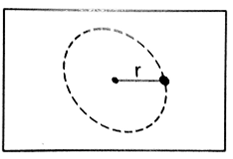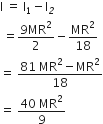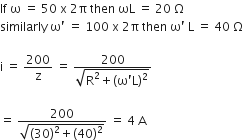A small mass attached to a string rotats on frictionless table top as shown. If the tension is the string is increased by pulling the string causing the radius of the circular motion to decrease by a factor of 2, the kinetic energy of the mass will
remain constant
increase by a factor of 2
increase by a factor 4
increase by a factor 4
C.
increase by a factor 4
From the law of conservation of angular momentum
From a circular disc of radius R and mass 9M, a small disc of mass M and radius R/3 is removed concentrically. The moment of inertia of the remaining disc about an axis perpendicular to the plane of the disc and passing through its centre is
40MR2/9
MR2
4 MR2
4 MR2
A.
40MR2/9
The moment of inertia of the remaining disc about axis perpendicular to the plane of the disc and passing through its centre.
A coil has resistance 30 O and inductive reactance 20 O at 50 Hz frequency. If an AC source 200 V, 100 Hz, is connected across the coil, the current in the coil will be
4.0 A
8.0 A


A.
4.0 A

A circular disk of moment of inertia It is rotating in a horizontal plane, about its symmetry axis, with a constant angular speed. Another disk of moment of inertia Ib is dropped coaxially onto the rotating disk. Initially, the second disk has zero angular speed. Eventually, both the disks rotate with constant angular speed.
Another disk of moment of inertia Ib is dropped coaxially onto the rotating disk. Initially, the second disk has zero angular speed. Eventually, both the disks rotate with constant angular speed. The energy lost by the initially rotating disc due to friction is
The energy lost by the initially rotating disc due to friction is




D.

Loss of energy, 
A gramophone record is revolving with an angular velocity ω. A coin is placed at a distance r from the centre of the record. The static coefficient of friction is μ. The coin will revolve with the record if
r = μgω2



C.

When the disc spins the frictional force between the gramophone record and coin is μ mg
The coin will revolve with record, if 
